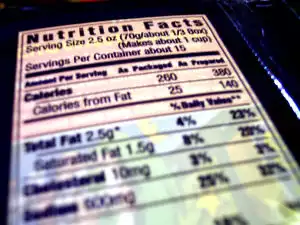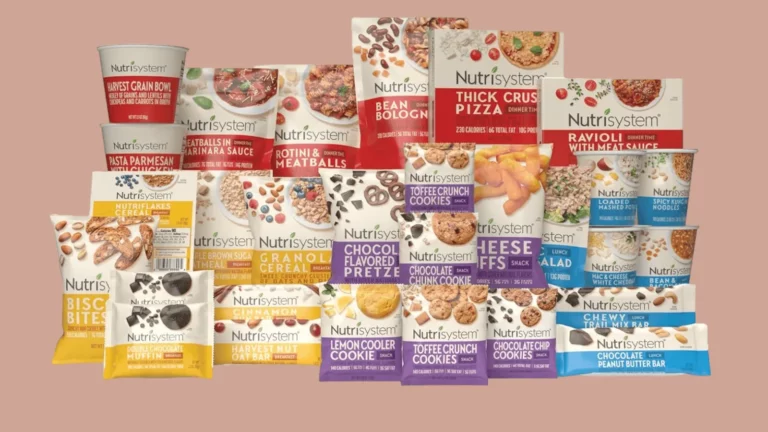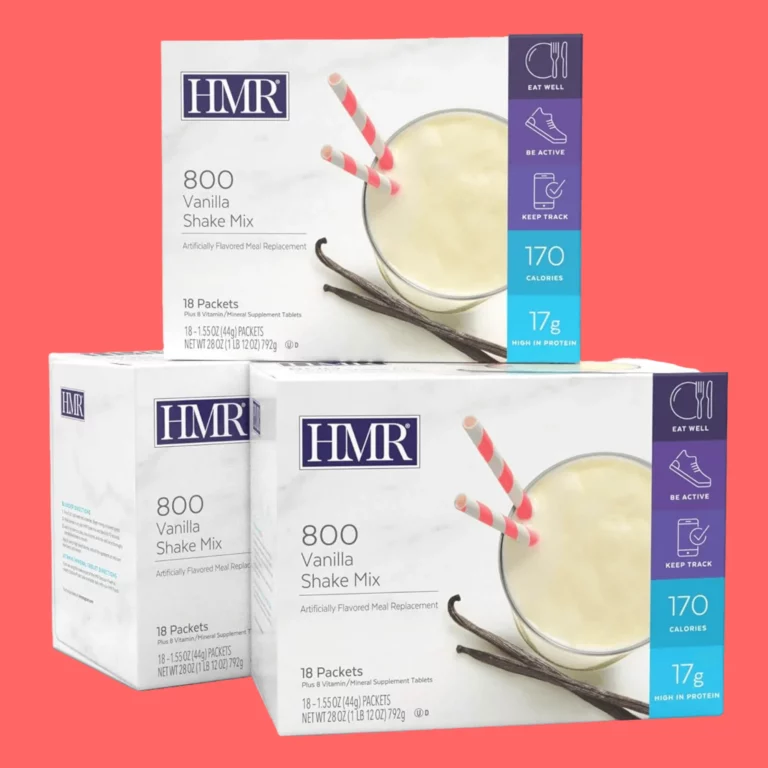Understanding nutrition labels is crucial for making informed decisions about the foods we consume.
It is important to have a clear and simple Nutritional Label Interpretation understanding to properly plan your weightloss regemen.
These labels provide information on serving sizes, calories, nutrients, and ingredients contained in a product.
By paying attention to these details, individuals can effectively manage their daily intake of important nutrients such as fats, sugars, and vitamins.
The serving size indicates the amount of food typically consumed at one sitting and helps in understanding the rest of the information on the label.
Calories per serving reveal how much energy is provided by the food item. Nutrients like proteins, carbohydrates, fiber, and various vitamins and minerals are listed with their respective percentages based on daily values.
Pay attention to Percent Daily Value (% DV) which tells you if a serving of food contributes high or low amounts of specific nutrients based on a 2,000-calorie diet.
Limit saturated fats, trans fats, cholesterol, added sugars, and sodium in your diet as excessive consumption can lead to health issues. Ingredients are listed in descending order by weight; look out for hidden sources of added sugars or unhealthy fats.
Incorporating this knowledge into your shopping routine can help you choose healthier options that align with your dietary goals.
Practice reading nutrition labels regularly to become more mindful of what you eat and make choices that promote overall well-being.
Table of Contents for Nutritional Label Interpretation
Saturated Fat
Saturated fat free: Less than 1/2 gram saturated fat in a serving; levels of trans fatty acids must be not more than 1 percent of total fat.
Low saturated fat: 1 gram saturated fat or less in a serving and 15 percent or less of calories from saturated fat.
For a meal or main dish (like a frozen dinner): 1 gram saturated fat or less in 100 grams of food and less than 10 percent of calories from saturated fat.
Saturated fats are a type of fat found in certain foods, such as meat and dairy products.
They are known to increase levels of LDL cholesterol in the body, which can contribute to heart disease.
It is important to pay attention to the amount of saturated fat listed on nutrition labels, as high intake can negatively impact health.
Foods high in saturated fat include fried foods, pastries, and processed meats. Health organizations recommend limiting saturated fat intake to reduce the risk of heart disease.
To make healthier choices, opt for foods that are low in saturated fats and instead rich in unsaturated fats like those found in nuts and avocados.
Being mindful of your saturated fat consumption can help improve overall health and well-being.
Aiming for a balanced diet that includes a variety of nutrients is key for maintaining optimal health.
By reading nutrition labels carefully and being aware of the sources of saturated fats in your diet, you can better manage your overall intake.
Making simple swaps like choosing leaner cuts of meat or using olive oil instead of butter can help lower your saturated fat consumption.
Remember that small changes over time can lead to big improvements in your health outcomes.
Consider consulting with a registered dietitian for personalized advice on how to best meet your dietary needs while managing your intake of saturated fats.
Cholesterol
Cholesterol free: Less than 2 milligrams (mg) cholesterol in a serving; saturated fat content must be 2 grams or less in a serving.
Low cholesterol: 20 mg cholesterol or less in a serving; saturated fat content must be 2 grams or less in a serving. For a meal or main dish: 20 mg cholesterol or less in 100 grams of food, with saturated fat content less than 2 grams in 100 grams of food.
Cholesterol is a type of fat that is essential for our body’s function, but too much of it can increase the risk of heart disease.
When reading nutrition labels, it is important to pay attention to the levels of saturated and trans fats, as these can raise cholesterol levels.
Saturated fats are typically found in animal products like meat and dairy, while trans fats are often found in processed foods.
Consuming foods high in fiber, such as fruits and vegetables, can help lower cholesterol levels.
It is recommended to limit intake of foods high in cholesterol, such as eggs and shellfish.
Opting for healthier cooking methods, such as grilling or baking instead of frying, can also help reduce cholesterol intake.
Regular physical activity is another key factor in maintaining healthy cholesterol levels.
Exercise can not only lower LDL (bad) cholesterol but also raise HDL (good) cholesterol. By being mindful of your diet and lifestyle choices, you can better manage your cholesterol levels and reduce your risk of heart disease.
Fat
Understanding the nutrition labels on food products is key to managing your fat intake.
When reading a nutrition label, pay attention to the total fat and saturated fat content per serving.
Total fat includes both healthy fats like unsaturated fats and unhealthy fats like saturated fats and trans fats.
Saturated fats can increase cholesterol levels, while trans fats are linked to heart disease.
Look for products that have lower amounts of saturated and trans fats, and higher amounts of unsaturated fats.
These healthier fats are found in foods like nuts, seeds, avocado, and olive oil.
Keep in mind that the recommended daily intake of fat for most adults is around 20-35% of total calories consumed.
By understanding nutrition labels and making informed choices, you can better manage your fat intake for overall health and well-being.
Fat free: Less than 1/2 gram fat in a serving.
Low fat: 3 grams total fat or less in a serving.
For a meal or main dish: 3 grams total fat or less in 100 grams of food and not more than 30 percent calories from fat.
Percent fat free–A food with this claim must also meet the low fat claim.
Calories
Understanding nutrition labels is crucial for managing your calorie intake.
Calories are a measure of the energy provided by food and beverages. On nutrition labels, the number of calories per serving is prominently displayed.
It’s essential to pay attention to serving sizes as well, as they can greatly affect calorie consumption.
Different nutrients provide different amounts of calories – for example, fats provide more calories per gram than carbohydrates or protein.
By familiarizing yourself with nutrition labels and understanding calorie content, you can make more informed choices about your diet.
Keeping track of daily calorie intake can help you maintain a healthy weight and overall well-being. Remember that everyone has different caloric needs based on factors like age, sex, activity level, and health goals.
Calorie free: Less than 5 calories in a serving.
Low calorie: 40 calories or less in a serving.
Sodium
Sodium is an essential mineral that plays a crucial role in maintaining fluid balance, muscle function, and nerve transmission in the body.
However, excessive intake of sodium can lead to health problems such as high blood pressure and an increased risk of heart disease.
When reading nutrition labels, it’s important to pay attention to the sodium content of foods.
The daily recommended intake of sodium for adults is around 2,300 milligrams, but many processed and packaged foods contain high amounts of sodium.
To make healthier choices, look for products labeled as low-sodium or sodium-free.
Be mindful of serving sizes as the sodium content listed on nutrition labels is often based on a single serving size.
Opting for fresh fruits and vegetables, lean proteins, and whole grains can help you reduce your overall sodium intake.
It’s also advisable to limit the consumption of salty snacks, canned soups, and processed meats which are notorious for their high sodium content.
By understanding how to interpret nutrition labels and making informed food choices, you can better manage your sodium intake and support your overall health and well-being.
Sodium free: Less than 5 mg sodium in a serving.
Low sodium: 140 mg sodium or less in a serving. For a meal or main dish: 140 mg sodium or less in 100 grams of food. Very low sodium: 35 mg sodium or less in a serving.
Words that mean the same thing as free: “no,” “zero,” “without,” “trivial source of,” “negligible source of,” and “dietary insignificant source of.”
Words that mean the same thing as low: “contains a small amount of” and “low source of.”
Light
A product has been changed to have half the fat or one-third fewer calories than the regular product; or the sodium in a low calorie, low fat food has been cut by 50 percent; or a meal or main dish is low fat or low calorie.
“Light” also may be used to describe things like the color or texture of a food, as long as the label explains this: for example, “light brown sugar” or “light and fluffy.”
Reduced/Less/Lower/Fewer–A food (like a lower-fat hot dog or a lower-sodium cracker) has at least 25 percent less of something like calories, fat, saturated fat, cholesterol, or sodium than the regular food or a similar food to which it is compared.
Lean and Extra Lean–Two terms–“lean” and “extra lean”–are used to describe the fat content of meat, poultry, fish, and shellfish.
Lean
Less than 10 grams fat, 4.5 grams or less of saturated fat, and less than 95 mg cholesterol in a serving.
Extra lean– Less than 5 grams fat, less than 2 grams saturated fat, and less than 95 mg cholesterol in a serving.







